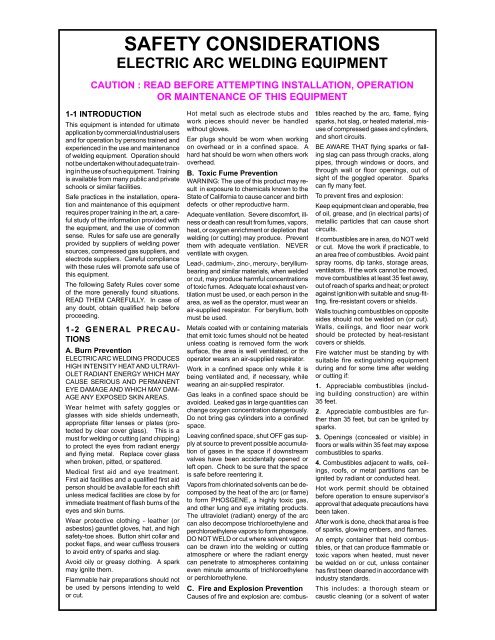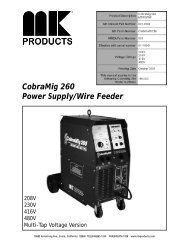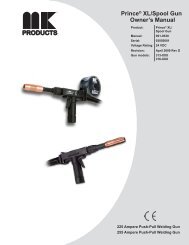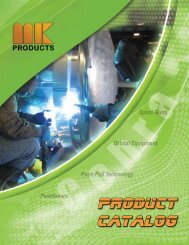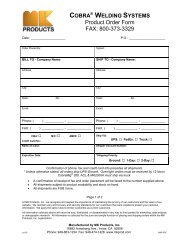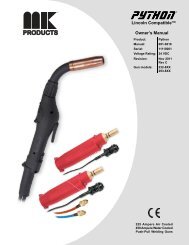CobraTig® 150 XM Owner's Manual - MK Products
CobraTig® 150 XM Owner's Manual - MK Products
CobraTig® 150 XM Owner's Manual - MK Products
You also want an ePaper? Increase the reach of your titles
YUMPU automatically turns print PDFs into web optimized ePapers that Google loves.
SAFETY CONSIDERATIONSELECTRIC ARC WELDING EQUIPMENTCAUTION : READ BEFORE ATTEMPTING INSTALLATION, OPERATIONOR MAINTENANCE OF THIS EQUIPMENT1-1 INTRODUCTIONThis equipment is intended for ultimateapplication by commercial/industrial usersand for operation by persons trained andexperienced in the use and maintenanceof welding equipment. Operation shouldnot be undertaken without adequate trainingin the use of such equipment. Trainingis available from many public and privateschools or similar facilities.Safe practices in the installation, operationand maintenance of this equipmentrequires proper training in the art, a carefulstudy of the information provided withthe equipment, and the use of commonsense. Rules for safe use are generallyprovided by suppliers of welding powersources, compressed gas suppliers, andelectrode suppliers. Careful compliancewith these rules will promote safe use ofthis equipment.The following Safety Rules cover someof the more generally found situations.READ THEM CAREFULLY. In case ofany doubt, obtain qualified help beforeproceeding.1-2 GENERAL PRECAU-TIONSA. Burn PreventionELECTRIC ARC WELDING PRODUCESHIGH INTENSITY HEAT AND ULTRAVI-OLET RADIANT ENERGY WHICH MAYCAUSE SERIOUS AND PERMANENTEYE DAMAGE AND WHICH MAY DAM-AGE ANY EXPOSED SKIN AREAS.Wear helmet with safety goggles orglasses with side shields underneath,appropriate filter lenses or plates (protectedby clear cover glass). This is amust for welding or cutting (and chipping)to protect the eyes from radiant energyand flying metal. Replace cover glasswhen broken, pitted, or spattered.Medical first aid and eye treatment.First aid facilities and a qualified first aidperson should be available for each shiftunless medical facilities are close by forimmediate treatment of flash burns of theeyes and skin burns.Wear protective clothing - leather (orasbestos) gauntlet gloves, hat, and highsafety-toe shoes. Button shirt collar andpocket flaps, and wear cuffless trousersto avoid entry of sparks and slag.Avoid oily or greasy clothing. A sparkmay ignite them.Flammable hair preparations should notbe used by persons intending to weldor cut.Hot metal such as electrode stubs andwork pieces should never be handledwithout gloves.Ear plugs should be worn when workingon overhead or in a confined space. Ahard hat should be worn when others workoverhead.B. Toxic Fume PreventionWARNING: The use of this product may resultin exposure to chemicals known to theState of California to cause cancer and birthdefects or other reproductive harm.Adequate ventilation. Severe discomfort, illnessor death can result from fumes, vapors,heat, or oxygen enrichment or depletion thatwelding (or cutting) may produce. Preventthem with adequate ventilation. NEVERventilate with oxygen.Lead-, cadmium-, zinc-, mercury-, berylliumbearingand similar materials, when weldedor cut, may produce harmful concentrationsof toxic fumes. Adequate local exhaust ventilationmust be used, or each person in thearea, as well as the operator, must wear anair-supplied respirator. For beryllium, bothmust be used.Metals coated with or containing materialsthat emit toxic fumes should not be heatedunless coating is removed form the worksurface, the area is well ventilated, or theoperator wears an air-supplied respirator.Work in a confined space only while it isbeing ventilated and, if necessary, whilewearing an air-supplied respirator.Gas leaks in a confined space should beavoided. Leaked gas in large quantities canchange oxygen concentration dangerously.Do not bring gas cylinders into a confinedspace.Leaving confined space, shut OFF gas supplyat source to prevent possible accumulationof gases in the space if downstreamvalves have been accidentally opened orleft open. Check to be sure that the spaceis safe before reentering it.Vapors from chlorinated solvents can be decomposedby the heat of the arc (or flame)to form PHOSGENE, a highly toxic gas,and other lung and eye irritating products.The ultraviolet (radiant) energy of the arccan also decompose trichloroethylene andperchloroethylene vapors to form phosgene.DO NOT WELD or cut where solvent vaporscan be drawn into the welding or cuttingatmosphere or where the radiant energycan penetrate to atmospheres containingeven minute amounts of trichloroethyleneor perchloroethylene.C. Fire and Explosion PreventionCauses of fire and explosion are: combustiblesreached by the arc, flame, flyingsparks, hot slag, or heated material, misuseof compressed gases and cylinders,and short circuits.BE AWARE THAT flying sparks or fallingslag can pass through cracks, alongpipes, through windows or doors, andthrough wall or floor openings, out ofsight of the goggled operator. Sparkscan fly many feet.To prevent fires and explosion:Keep equipment clean and operable, freeof oil, grease, and (in electrical parts) ofmetallic particles that can cause shortcircuits.If combustibles are in area, do NOT weldor cut. Move the work if practicable, toan area free of combustibles. Avoid paintspray rooms, dip tanks, storage areas,ventilators. If the work cannot be moved,move combustibles at least 35 feet away,out of reach of sparks and heat; or protectagainst ignition with suitable and snug-fitting,fire-resistant covers or shields.Walls touching combustibles on oppositesides should not be welded on (or cut).Walls, ceilings, and floor near workshould be protected by heat-resistantcovers or shields.Fire watcher must be standing by withsuitable fire extinguishing equipmentduring and for some time after weldingor cutting if:1. Appreciable combustibles (includingbuilding construction) are within35 feet.2. Appreciable combustibles are furtherthan 35 feet, but can be ignited bysparks.3. Openings (concealed or visible) infloors or walls within 35 feet may exposecombustibles to sparks.4. Combustibles adjacent to walls, ceilings,roofs, or metal partitions can beignited by radiant or conducted heat.Hot work permit should be obtainedbefore operation to ensure supervisor’sapproval that adequate precautions havebeen taken.After work is done, check that area is freeof sparks, glowing embers, and flames.An empty container that held combustibles,or that can produce flammable ortoxic vapors when heated, must neverbe welded on or cut, unless containerhas first been cleaned in accordance withindustry standards.This includes: a thorough steam orcaustic cleaning (or a solvent of water


